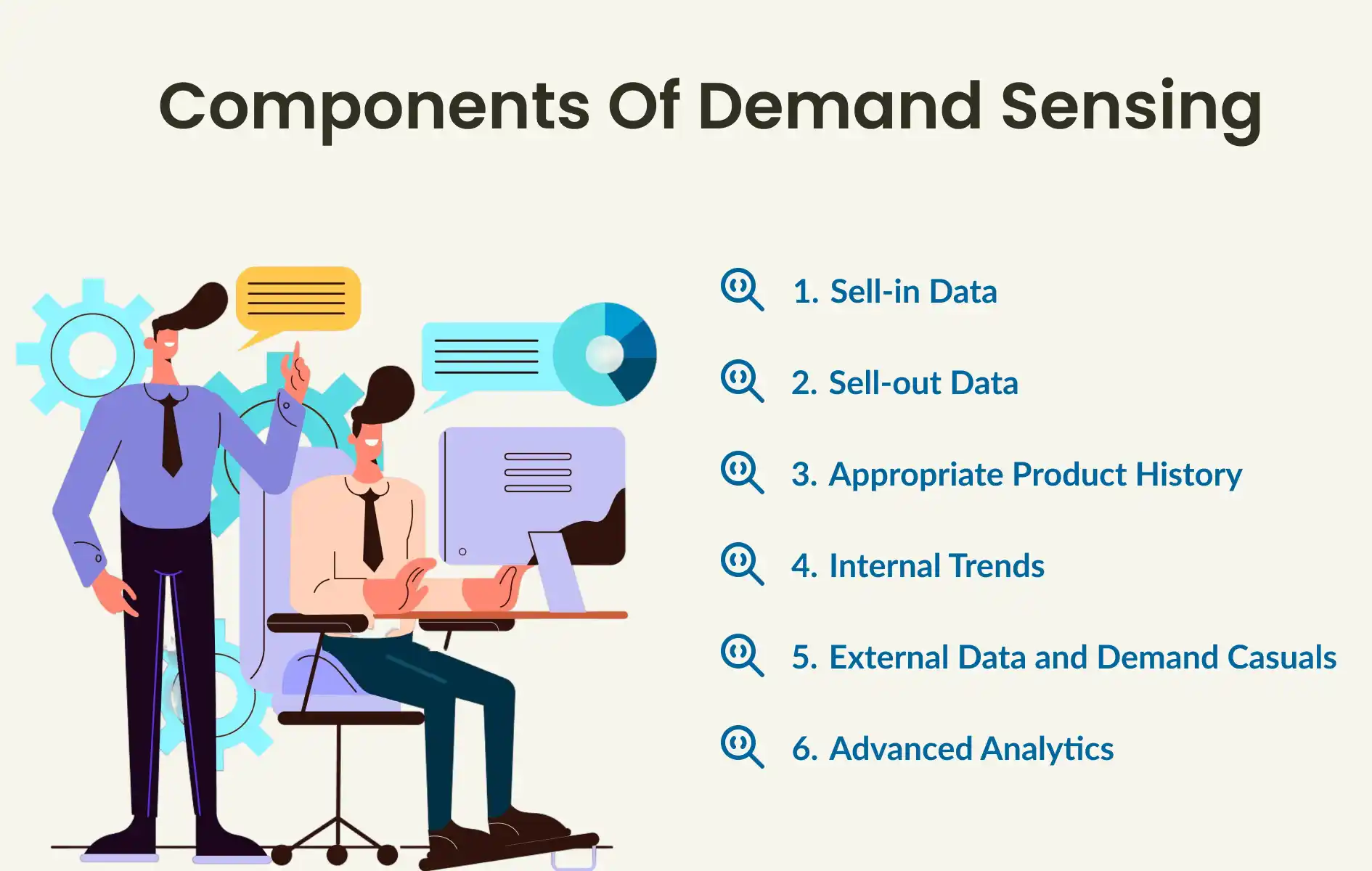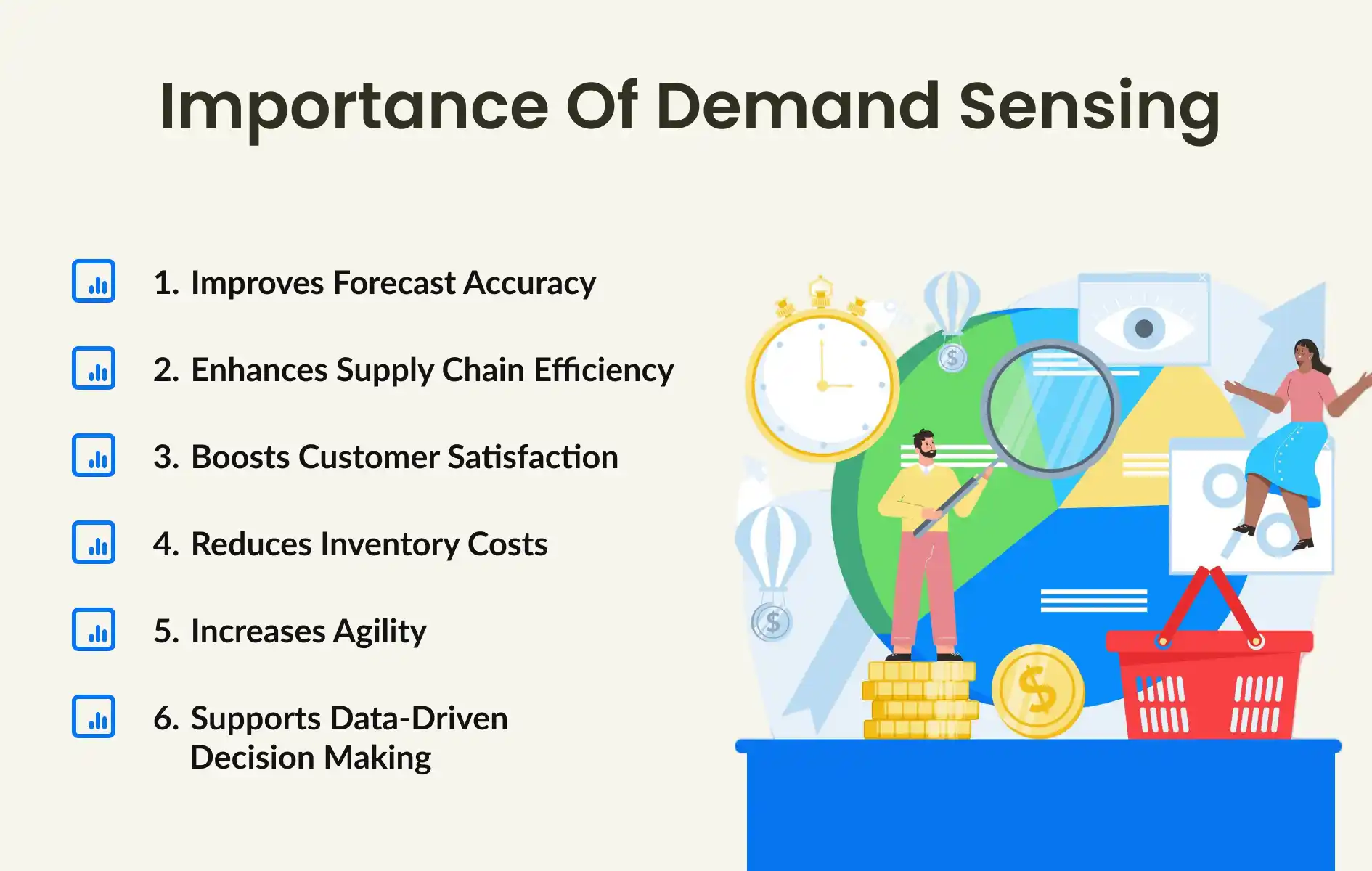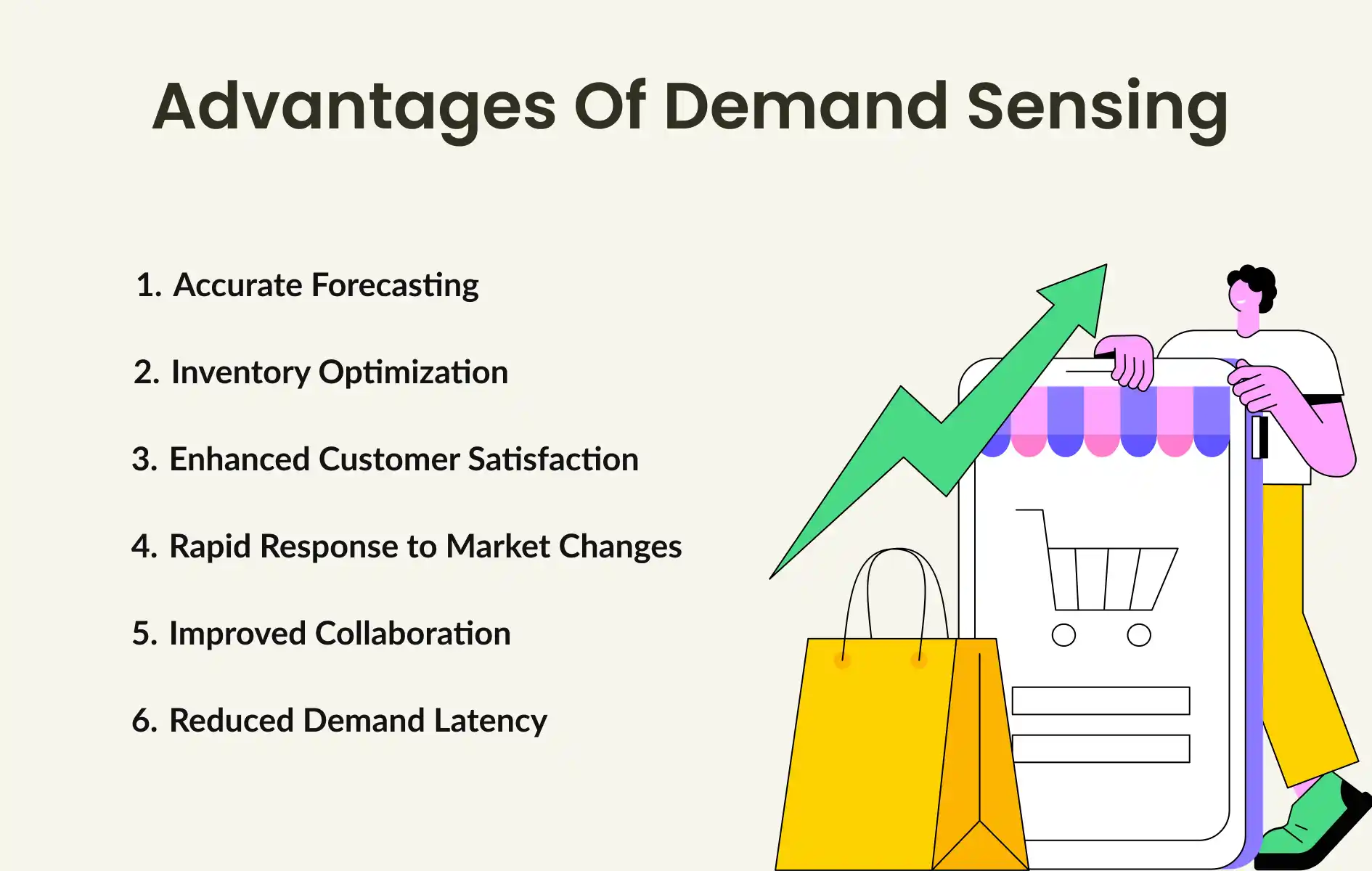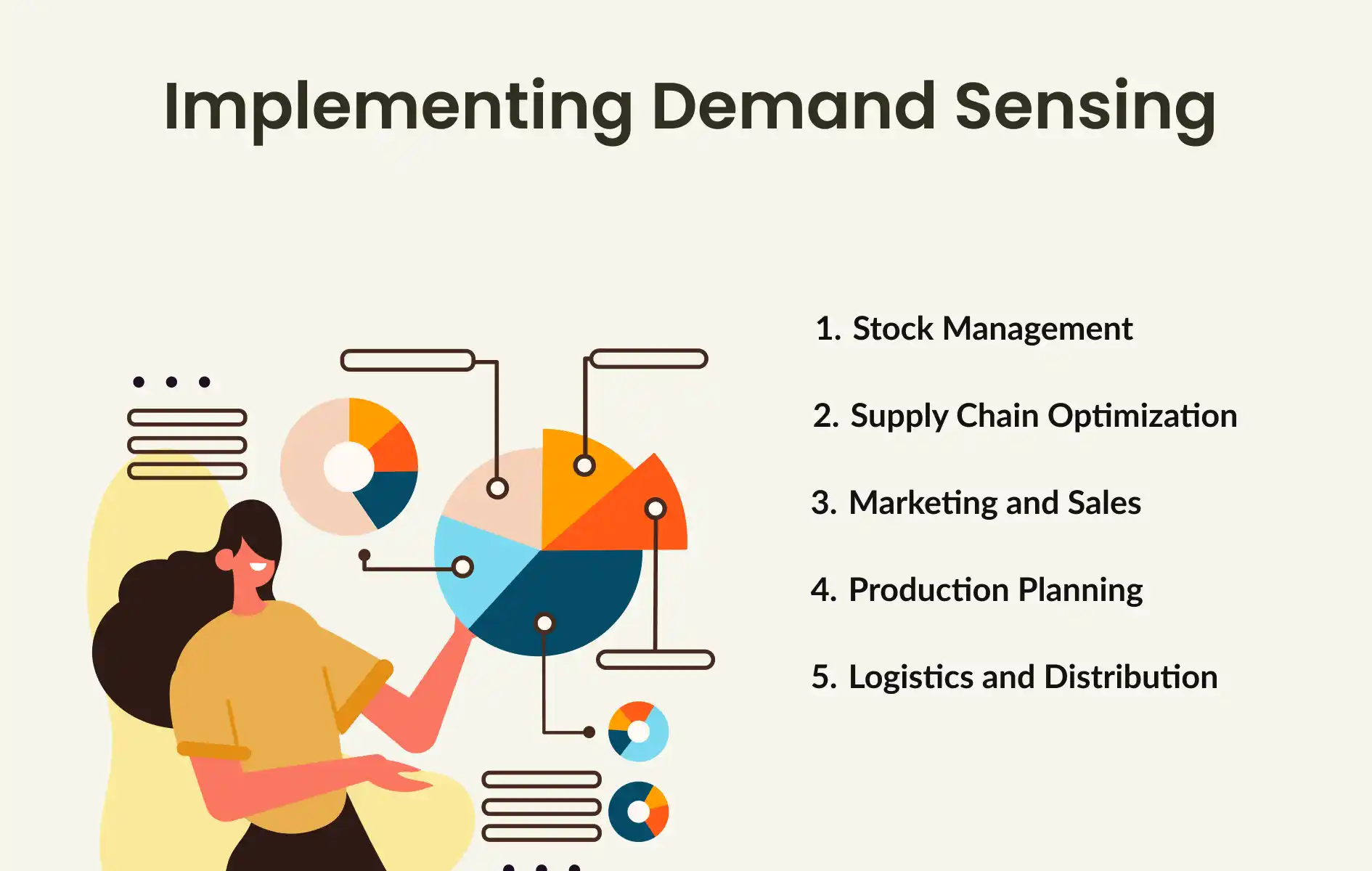What is Demand Sensing and Why is it Important? | thouSense

Demand sensing is a cutting-edge approach. Demand sensing helps businesses accurately forecast and adapt to changing consumer demand. Now a question arises, Is it possible? The answer is “Yes it is!”. By providing advanced analytics and real-time data. It empowers companies to optimize inventory levels, minimize waste, and enhance customer satisfaction, ultimately driving business success.
What is Demand Sensing?
It is a data-driven approach that uses real-time analytics. This helps to forecast and adapt to changing consumer demand. It enables businesses to optimize inventory levels. And, also it reduces waste and improves customer satisfaction.
Key Components of Demand Sensing
The following are the few important key components:

1. Sell-in Data
Accurate data on daily sales is crucial for forecasting demand. It is one of the essential parts of demand sensing. It involves daily granular data on sales inputs to forecast demand for shorter periods. And, help in providing real-time visibility and accuracy.
2. Sell-out Data
Sell-out data refers to downstream sell-out information from customers, point-of-sale, or channels. It helps identify sudden demand shifts and provides timely warnings for businesses. This helps businesses to adjust production and inventory accordingly.
3. Appropriate Product History
Historical data is essential, but only data from relevant periods should be used to predict future demand. It helps to provide accurate predictions by avoiding old or irrelevant data. "Appropriate Product History" in demand sensing refers to employing a certain period of historical data that correlates with current desires.
4. Internal Trends
In demand sensing, internal trends are patterns and variations found in an organization's data. It includes sales rates, inventory levels, and production capacity. These are examined to provide short-term demand projections.
5. External Data and Demand Casuals
Demand sensors must include both external data and demand factors. They offer important insights into uncontrollable variables. It might have a big impact on demand. Like social media activity, economic trends, and weather patterns.
6. Advanced Analytics
AI-powered demand sensing solutions use these data to analyze and predict short-term demand changes. It enables timely responses to market shifts. To produce precise demand projections, advanced analytics in demand sensing entails applying refined statistical and machine learning algorithms to analyze real-time data from several sources and spot intricate patterns and trends.
How does Demand Sensing stand out from traditional Demand Forecasting?
It stands out from traditional demand forecasting by supplying real-time data. And, advanced analytics to accurately predict short-term demand changes. Unlike ancient methods, demand sensing has been proactive to adapt market shifts. This adaptability nature of demand sensing allows businesses to adapt quickly and reduce inventory waste.
Why is Demand Sensing Important?
It is important for the following reasons:

1. Improves Forecast Accuracy
Demand sensing improves forecast accuracy at its best. Providing real-time data and advanced analytics enables businesses to meet short-term demand changes. And, make informed decisions, reducing the risk of inventory waste and overstocking.
2. Enhances Supply Chain Efficiency
It enhances supply chain efficiency by enabling timely adjustments. These adjustments are made for production and inventory levels. It is based on real-time demand data, ensuring a smoother supply chain operation, reduced costs, and improved responsiveness to customer needs.
3. Boosts Customer Satisfaction
It boosts customer satisfaction by allowing businesses to meet customer demand in real-time. It ensures product availability, reduces stockouts, and provides a seamless shopping experience. This in return builds brand loyalty and trust.
4. Reduces Inventory Costs
It reduces stock costs by accurately forecasting demand, allowing businesses to maintain optimal stock levels. This helps in minimizing waste, and reducing the need for costly stock write-offs or overstocking.
5. Increases Agility
Demand sensing increases agility by providing real-time insights into changing demand patterns. Now, how does this help businesses? So, it allows businesses to quickly respond to market shifts, and adapt to new trends. And, also to stay ahead of the competition.
6. Supports Data-Driven Decision Making
It supports decision-making by providing actionable insights. These insights enable businesses to make informed decisions based on real-time demand data. This new adaptability gives an end to old traditional methods.
Benefits of Demand Sensing
Demand Sensing has the following benefits:

1. Accurate Forecasting
Demand sensing supplies real-time data from various sources. It provides more accurate short-term demand forecasts. This helps businesses to make proper anticipation. And, helps in reducing forecast error rates.
2. Inventory Optimization
Accurate forecasting enables businesses to optimise stock levels, minimising excess stock and associated costs like storage and obsolescence.
3. Enhanced Customer Satisfaction
Demand Sensing ensures product availability and timely delivery to their customer. This helps in improving the customer experience and increases loyalty.
4. Rapid Response to Market Changes
Demand sensing allows businesses to quickly adapt to sudden shifts in demand, by giving them a competitive edge in volatile markets.
5. Improved Collaboration
Real-time insights from demand sensing help align various departments, enhancing cross-functional collaboration.
6. Reduced Demand Latency
Demand sensing solutions powered by Artificial Intelligence and machine learning can process vast amounts of data. It identifies patterns, and continuously improves accuracy over time. This helps in minimising the time between demand events and the supply chain's response.
Application of Demand Sensing

1. Stock Management
It improves inventory control by giving real-time information to optimize. It also helps with stock levels, lowering stockouts and overstocking, and raising customer satisfaction. This is done by prompt product availability and effective replenishment tactics.
2. Supply Chain Optimization
By supplying real-time data, it enables businesses to adjust in certain areas. Those areas are production schedules, procurement strategies, and logistics to meet actual market demand.
3. Marketing and Sales
It provides insights into consumer behaviour. Enabling targeted marketing campaigns and sales strategies to maximise revenue. This helps businesses for healthy growth.
4. Production Planning
It helps manufacturers adjust production levels to meet changing demand. This also helps in reducing waste and improving product availability.
5. Logistics and Distribution
Optimizes logistics and distribution by ensuring the timely delivery of products. This helps in achieving customer satisfaction and also reduces transportation costs.
Overcoming Challenges: thouSense's Approach to Accurate Forecasting and Real-Time Insights
At thouSense, challenges related to demand sensing are tackled with modern approaches and technology.
1. Data Quality and Integration
thouSense obtains unified data of high quality from a wide range of sources. Those sources include point-of-sale, e-commerce, and social media, to provide accurate demand insights.
2. Machine Learning and AI
Advanced AI and machine learning algorithms are used to analyse large volumes of data, identify patterns, and predict future demand with high accuracy.
3. Real-time Analytics
thouSense leverages real-time analytics to provide timely and actionable insights, enabling businesses to respond quickly to changing market conditions.
4. Collaborative Approach
thouSense fosters collaboration between various departments and stakeholders. Just to ensure that insights are integrated into business decisions and operations.
5. Continuous Improvement
thouSense continuously monitors and improves its demand sensing solutions. To adapt to evolving market trends and consumer behaviour.
6. Customized Solutions
thouSense offers customized solutions tailored to the specific needs of each business. This ensures that the solution is aligned with the company's goals and objectives.
Conclusion
To sum up, demand sensing is an effective instrument that helps companies negotiate the challenges of the fast-paced market of today. It optimizes inventory levels. And, boosts supply chain efficiency. It helps to produce accurate forecasts by supplying the power of real-time data and refined analytics. Demand sensing will be more and more important for companies trying to remain ahead of the competition as customer behaviour changes.
FAQs
Q. What is the primary goal of demand sensing?
Answer: The primary goal is to accurately forecast and adapt to changing consumer demand in real-time, enabling businesses to optimize inventory levels, reduce waste, and improve customer satisfaction, ultimately driving business success.
Q. Why are demand data so important?
Answer: Demand data is essential because it gives businesses instantaneous insights into consumer behaviour, empowering them to make well-informed decisions regarding price, inventory, and production. Precise demand information promotes revenue development, enhances customer satisfaction, and cuts waste.
Q. How to do demand sensing?
Answer: Demand sensing's main objective is to precisely predict and adjust to shifting consumer demand in real-time, allowing companies to maximize inventory levels, cut costs, and raise customer satisfaction—all of which contribute to their success.
Q. What is the Best Demand Sensing Software?
Answer: There are several demand-sensing solutions available in the market. With a wide variety of demand-sensing software, one should opt for the ones supported with features and personalized options that work with the support of artificial intelligence and machine learning. One of the best demand sensing software in the current market includes thouSense which caters to the needs of businesses the best.